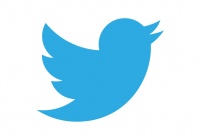Twitter is a social networking and microblogging site that was founded in 2006 by Jack Dorsey, Noah Glass, Evan Williams, and Biz Stone.[1] Once registered, Twitter users can send, read, favorite, or share 'tweets'. Tweets are messages that are limited to 140 characters.[2] After its founding, Twitter grew incredibly quickly, amassing half a billion users who tweeted three hundred and forty tweets a day by the end of 2012.[3]
History
Twitter was created by Jack Dorsey, Noah Glass,Evan Williams, and Biz Stone while they worked for Odeo, a podcasting company. During a day long of brainstorming, they created the website to act as a SMS service for small groups.[4] Twitter's original name was twttr; inspired by flickr. Dorsey explains that: “[they] came across the word 'twitter', and it was just perfect. The definition was 'a short burst of inconsequential information,' and 'chirps from birds'. And that's exactly what the product was.”[5]
Twitter reached its critical mass during the 2007 South by Southwest interactive conference where the website was received incredibly well by consumers.[6] It was so well received that the number of tweets per day increased from twenty thousand to sixty thousand immediately following the conference.[7] Soon after this success, Twitter grew incredibly quickly reaching the bench mark of 100 million tweets per quarter by the end of 2008. As of September 2013, approximately four hundred million tweets are made each day.[8]
Uses and Features of Twitter
Twitter is a highly interactive site that allows for large scale spreading of information. Although limited to a specific number of characters (140), Twitter is a way for people to send out multiple messages to the online world. Twitter allows its users to create profiles, and these profiles give users the opportunity to interact with fellow Tweeters. Twitter facilitates interactivity through the "retweet", "quote tweet", and "favorite tweet" features. All of these features help to extend the audience of a particular tweet by posting the tweet to another user's profile, which can then be viewed by all of their followers. Thus, these tools allow for personal tweets to have a potentially unlimited reach, assuming any given user has a public profile. The identity of the users on Twitter develops through their tweets. The actual profile of a person on Twitter is an outline of their tweets and retweets. Other users get a taste of a Tweeter's personality by the variety in their tweets and retweets.
"Following" is one of the most important parts of Twitter's community formation. Users decide whose tweets they would like to see in their feed by choosing to follow specific accounts. Since following is not mutual - like "friending" on Facebook, for example - users may have a large disparity between number of followers they have and the number of people they follow. This discrepancy often means that celebrities and those who have formed strong networks on Twitter will have many followers, while most people will relatively very few. A clear power dynamic emerges, as those with many followers have the potential to have their tweets read by a wider range of people. Such a system also gives users a sense of their audience, although any tweet could potentially be read by any Twitter user, or be seen by only a few of a person's followers.
Another key feature of Twitter is its structure. With the "hashtag" referencing system, users can search for different topics. Because the reach of twitter is so expansive, hashtags allow for users to focus in on individual topics and form digital communities around ideas, activities, and news that interest them.[9] Moreover, unlike other mediums, Twitter is neither a completely synchronous method of communication nor is it completely asynchronous. As a result, Twitter can be used conversationally or for broadcasting purposes. Twitter really excels as a broadcasting tool. Because users are able to replicate and share tweets easily through Twitter's retweet function, important, interesting, or amusing tweets can be seen by many users very quickly.
Analysis
Communication over Twitter is very different than oral communication or written communication. Nancy Baym's seven key concepts help describe Twitter's difference. For interactivity, Twitter is extremely conversational, people can write tweets, respond to tweets, favorite tweets, etc. Twitter communication can be both synchronous and asynchronous allowing for a great amount of interactivity between an unlimited amount of people. Tweets last a very long time and are potentially permanent. Twitter is very easily used on a mobile device and therefore allows for continuous use throughout the day. The mobility Twitter is limitless as long as one has a device. Tweets can be shared to a potentially unlimited amount of people and therefore allow for a good way of getting personal interests through to many people and to a variety of people that may or may not have that same interests. The hashtags are helpful in connecting people as they are used to bring people with similar interests together.
References
- ↑ "Twitter." Wikipedia. Wikimedia Foundation, 31 Oct. 2013. Web. 31 Oct. 2013.
- ↑ "Twitter." Wikipedia. Wikimedia Foundation, 31 Oct. 2013. Web. 31 Oct. 2013.
- ↑ "Growth in Numbers: A Look into Twitter Usage." Lieberman Technologies. Lieberman Technologies, 28 Apr. 2013. Web. 31 Oct. 2013.
- ↑ "Twitter." Wikipedia. Wikimedia Foundation, 31 Oct. 2013. Web. 31 Oct. 2013.
- ↑ Sano, David (February 18, 2009). "Twitter Creator Jack Dorsey Illuminates the Site's Founding Document". Los Angeles Times. Retrieved June 18, 2009
- ↑ "Twitter." Wikipedia. Wikimedia Foundation, 31 Oct. 2013. Web. 31 Oct. 2013.
- ↑ "Twitter." Wikipedia. Wikimedia Foundation, 31 Oct. 2013. Web. 31 Oct. 2013.
- ↑ "Twitter." Wikipedia. Wikimedia Foundation, 31 Oct. 2013. Web. 31 Oct. 2013.
- ↑ "Hashtag." Wikipedia. Wikimedia Foundation, 28 Oct. 2013. Web. 31 Oct. 2013.
